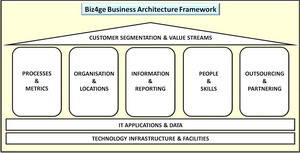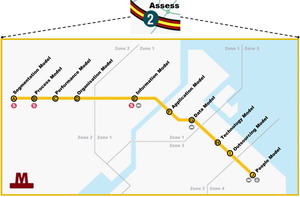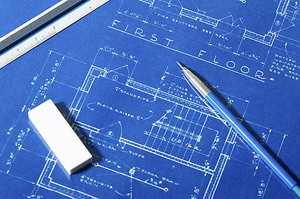Business Architecture
Well, this is it, we’ve arrived. As important as the content of the rest of this website is, this is to us the introduction to the single most important topic on these pages…….business architecture. Ironically its potential contribution to success is so large and its widespread use so relatively limited……but we hope to help change all that!
As is the case for business transformation, business architecture can at first appear complex and confusing, but it too has a basic pattern and structure that in overview looks something like the figure below (click on it to see an enlarged version in a new window).
As you can see, business architecture fits under the Assess stage of the business transformation roadmap. Each of the major elements or blueprint ‘layers’ in a business architecture is constructed in the routemap sequence outlined to the left. As for business transformation, there are interactions between each of the layers, but unlike business transformation there is much more iteration involved between and across each blueprint layer.
This is so much so that, especially in larger organisations, cross-functional teams will often be working on different parts of the architecture routemap in parallel. Therefore the way to read the routemap is not in a strict start-to-finish relationship way, but more as being about which routemap steps should be begun before others….and with the earlier steps also ideally normally completing before later steps complete.
Often what you learn from developing the model in a subsequent layer will cause you to want to go back and adjust work on ‘previous’ layers to be consistent. This is not only normal, and often necessary, but so long as it is not allowed to go too far and lead to chaos or analysis paralysis, it is a healthy sign of discovery and learning!
There are ten key model blueprint layers displayed on the Biz4ge business architecture routemap above, these are depicted in the business architecture framework diagram to the right (click on it to see an enlarged version in a new window).
displayed on the Biz4ge business architecture routemap above, these are depicted in the business architecture framework diagram to the right (click on it to see an enlarged version in a new window).
Additionally they are also detailed in list form below (follow the hyperlinks to learn more about each):
- Segmentation Model – sorts your customers and value streams into like-for-like clusters and groupings to maximise effectiveness and efficiency
- Process Model – builds the top-level process model representation of your organisation
- Performance Model – chooses the key performance metrics by which you will judge the operational success of your organisation
- Organisation Model – constructs the top-level model that will monitor, govern and control the business; it also specifies the physical locations involved
- Information Model – defines the minimum information the top-level roles require
- Application Model – matches software applications, as applicable, to the areas of the business they will enable
- Data Model – ensures that the organisation’s data will be consistent, coherent and accurate
- Technology Model – outlines what hardware, networks and other technical infrastructure will be required to support the business
- Outsourcing Model – specifies what aspects of the business will be operated in-house as opposed to those which will be outsourced
- People Model – assesses the gap between the people and skills available to the organisation versus those it will need, and forms plans to bridge the gap
There are also some further ‘enabling’ blueprint layer ‘tools’ which include downloadable source material for your use. Given their supporting ‘tools’ nature they are not depicted in the business architecture framework diagram. They are:
- Opportunity Assessment – survey based rapid assessment, keyed to the Biz4ge business architecture, to help determine likely areas of greatest opportunity in an organisation
- Source Material – documentation for business architecture level business processes and their definitions as well as selected business metrics and their definitions
We have also developed more detailed generic instances of all of the above, for products based organisations, for use with our clients. It gives them a major head-start in their efforts to improve their businesses. Whether they are looking for a highly tailored solution, or need a working combination of people, process and technology delivered quickly and cost effectively, you can read more about how we use the Biz4ge business architecture to good effect with clients at KzA and open4mgt respectively.
Now that we have had a good look at business architecting, and you are hopefully convinced of its many benefits, we would strongly encourage you to take the next step and get on and use it in anger! We would also encourage you, if you have not done so already, to peruse our Resources page and read and contribute your comments to the Biz4ge Blog!!
 If the content of this webpage makes you feel that being a member of our Biz4ge Network, or a Certified Affiliate within it, would be of benefit to you please Contact Us and we will get in touch by return. Your contact will be treated as confidential and will be at no cost or obligation to you.
If the content of this webpage makes you feel that being a member of our Biz4ge Network, or a Certified Affiliate within it, would be of benefit to you please Contact Us and we will get in touch by return. Your contact will be treated as confidential and will be at no cost or obligation to you.

